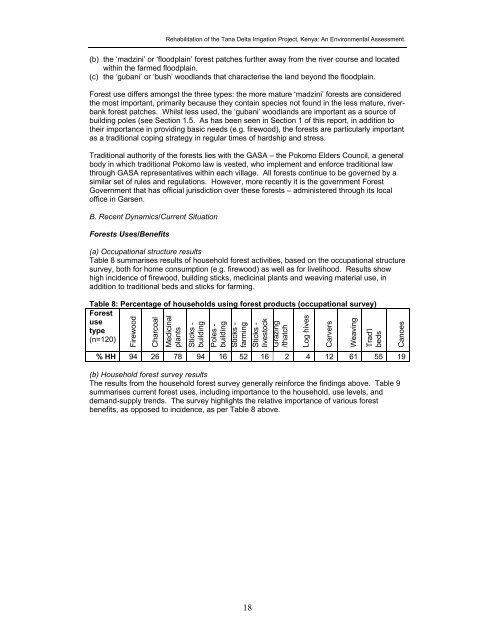Tana Delta Irrigation Project, Kenya: An Environmental Assessment
Tana Delta Irrigation Project, Kenya: An Environmental Assessment
Tana Delta Irrigation Project, Kenya: An Environmental Assessment
Create successful ePaper yourself
Turn your PDF publications into a flip-book with our unique Google optimized e-Paper software.
Rehabilitation of the <strong>Tana</strong> <strong>Delta</strong> <strong>Irrigation</strong> <strong>Project</strong>, <strong>Kenya</strong>: <strong>An</strong> <strong>Environmental</strong> <strong>Assessment</strong>.<br />
(b) the ‘madzini’ or ‘floodplain’ forest patches further away from the river course and located<br />
within the farmed floodplain.<br />
(c) the ‘gubani’ or ‘bush’ woodlands that characterise the land beyond the floodplain.<br />
Forest use differs amongst the three types: the more mature ‘madzini’ forests are considered<br />
the most important, primarily because they contain species not found in the less mature, riverbank<br />
forest patches. Whilst less used, the ‘gubani’ woodlands are important as a source of<br />
building poles (see Section 1.5. As has been seen in Section 1 of this report, in addition to<br />
their importance in providing basic needs (e.g. firewood), the forests are particularly important<br />
as a traditional coping strategy in regular times of hardship and stress.<br />
Traditional authority of the forests lies with the GASA – the Pokomo Elders Council, a general<br />
body in which traditional Pokomo law is vested, who implement and enforce traditional law<br />
through GASA representatives within each village. All forests continue to be governed by a<br />
similar set of rules and regulations. However, more recently it is the government Forest<br />
Government that has official jurisdiction over these forests – administered through its local<br />
office in Garsen.<br />
B. Recent Dynamics/Current Situation<br />
Forests Uses/Benefits<br />
(a) Occupational structure results<br />
Table 8 summarises results of household forest activities, based on the occupational structure<br />
survey, both for home consumption (e.g. firewood) as well as for livelihood. Results show<br />
high incidence of firewood, building sticks, medicinal plants and weaving material use, in<br />
addition to traditional beds and sticks for farming.<br />
Table 8: Percentage of households using forest products (occupational survey)<br />
Forest<br />
use<br />
type<br />
(n=120)<br />
Firewood<br />
Charcoal<br />
Medicinal<br />
plants<br />
Sticks -<br />
building<br />
Poles -<br />
building<br />
Sticks -<br />
farming<br />
Sticks -<br />
livestock<br />
Grazing<br />
/thatch<br />
Log hives<br />
Carvers<br />
Weaving<br />
Trad’l<br />
beds<br />
Canoes<br />
% HH 94 26 78 94 16 52 16 2 4 12 61 55 19<br />
(b) Household forest survey results<br />
The results from the household forest survey generally reinforce the findings above. Table 9<br />
summarises current forest uses, including importance to the household, use levels, and<br />
demand-supply trends. The survey highlights the relative importance of various forest<br />
benefits, as opposed to incidence, as per Table 8 above.<br />
18

















